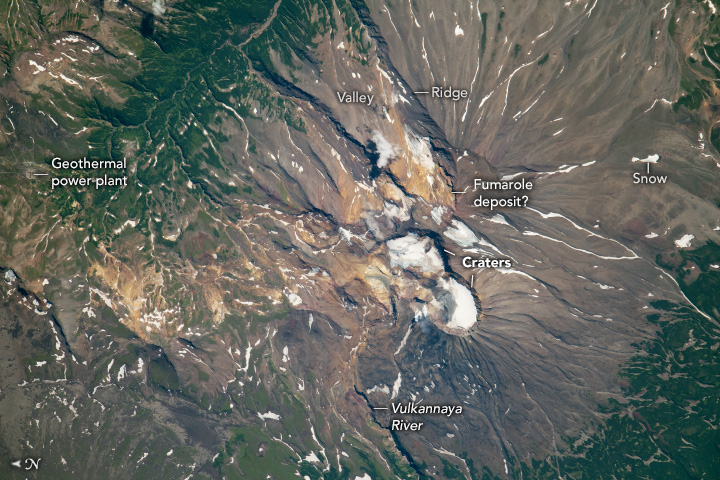Mutnovsky Volcano, located on Russia’s Kamchatka Peninsula, is a volcanic complex with numerous brown cinder cones and two large figure-eight-shaped craters. An astronaut aboard the International Space Station captured this high-resolution photograph of the volcano during the summer, yet the ridges radiating outward from the center cinder cone are topped by white snow and ice.
Most of the Kamchatka Peninsula, including Mutnovsky Volcano, lies at a latitude north of the space station’s orbital inclination, which is limited to latitudes 51.65 degrees north and south of the equator. To photograph regions at higher latitudes, an astronaut will typically use a high focal length lens with an oblique view.
Mutnovsky Volcano’s high latitude (52.4 degrees north of the equator), combined with its high elevation of over 7,000 feet (2,100 meters), helps it sustain glaciers and significant snow cover even during the region’s hotter months. Various hues of green vegetation fill the low-lying valleys, while the surrounding areas are covered by volcanic deposits.
Mutnovsky Volcano is one of the most active volcanoes in southern Kamchatka, with the most recent significant eruption occurring in 2000. The ridges and valleys of the volcanic complex visible in this image formed from material from past eruptions and subsequent erosion by rainfall and meltwater. The Vulkannaya, a river that flows out of the Northeast Crater, carries volcanic sediments downstream.
Along the northern flanks of Mutnovsky, lighter-brown to orange-tan hues are likely due to minerals deposited by the large fumarole field. Fumaroles are cracks that emit volcanic gases and steam, which can reach temperatures of several hundred degrees. The features typically host mineral deposits. The gas emissions enable people to harness the volcano’s geothermal energy. A geothermal power plant, visible as a circular feature north of the volcano, contributes significantly to the region’s power supply.
Astronaut photograph ISS069-E-71135 was acquired on August 19, 2023, with a Nikon D5 digital camera using a focal length of 1,150 millimeters. It is provided by the ISS Crew Earth Observations Facility and the Earth Science and Remote Sensing Unit, Johnson Space Center. The image was taken by a member of the Expedition 69 crew. The image has been cropped and enhanced to improve contrast, and lens artifacts have been removed. The International Space Station Program supports the laboratory as part of the ISS National Lab to help astronauts take pictures of Earth that will be of the greatest value to scientists and the public, and to make those images freely available on the Internet. Additional images taken by astronauts and cosmonauts can be viewed at the NASA/JSC Gateway to Astronaut Photography of Earth. Caption by Samantha Jacob, Barrios, JETS II Contract at NASA-JSC.
